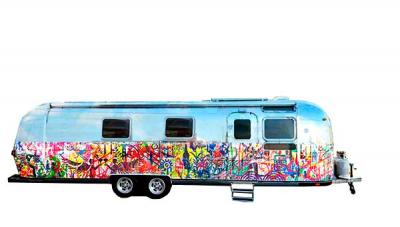Dream Machine Pulls Into Town

When Sara Meltzer and Suchi Reddy concocted the idea of the Dream Machine, a traveling pop-up art exhibition housed in a 1978 Airstream trailer, they didn’t realize the challenges of executing it. The hunk of aluminum needed three months’ work, and just as it neared completion, a worker peered underneath to discover rust coating the bottom. The unfortunate find proved a considerable setback.
But by last November, over a year after the original brainstorm, the Dream Machine appeared so polished it looked like someone could floss in its reflection. Its rounded ceiling is painted a soft, baby pink. Clean white cushions, cabinets, and shelves circle the perimeter. The vehicle is equipped with a working bathroom, and although no one has tried it yet, it can be lived and slept in.
Ms. Meltzer and Ms. Reddy, who are friends turned business partners and own the joint art and design firm WeR2, hauled the Dream Machine last fall to Connecticut to debut at the Aldrich Contemporary Art Museum. Since then, it has made high-profile appearances at Art Basel in Miami and the Highline in New York City. Now, it is coming to the Parrish Art Museum in Water Mill and will feature “Public Utility 2.0,” the latest policy work by the conceptual artist Mary Ellen Caroll.
For the Parrish exhibition, attendees entering the trailer will see a thin, black structure resembling a stingray attached to a reedy pole. This device functions like a two-way transmitter or antenna, directing frequency signals wirelessly to the Internet. The Dream Machine will serve as Ms. Caroll’s broadcast studio, where she will demonstrate how the frequencies work. There will also be ongoing discussions and interviews.
Ms. Carroll’s project utilizes old, defunct television channels, the kind that appeared as static back in the day, to create new networks and connect people in underserved communities to the Internet. These static channels, now known as super Wi-Fi, have become obsolete, and Ms. Carroll is recycling them to create a fast, wireless connection.
Ms. Carroll has long been interested in using public policy as a basis for her work. In 1999, she benefited from implementing super Wi-Fi for a piece to stream video of construction workers uprooting a single-family home from the ground and rotating it 180 degrees on its axis. This piece piqued her curiosity and dedication to discovering other ways radio frequencies can be used as a resource. This path eventually led to Public Utility 2.0, which launched in New Orleans after Hurricane Katrina. It helped provide Internet access to residents and government employees. Ms. Meltzer says this idea could benefit people here as well.
“You can be driving and all of a sudden your phone doesn’t work,” she said. “We have this free space and we should utilize that.”
Brightly colored beach towels depicting a map of used and unused frequency waves will be for sale. The pattern resembles a Tetris game of vivid rainbow blocks fused together.
The Dream Machine will be at the Parrish Art Museum from today through Sunday, 10 a.m. to 5 p.m. The trailer will then be stationed at the Silas Marder Gallery in Bridgehampton until Sept. 7, where it will sell modern design wares by various artists.
After Labor Day, Ms. Meltzer and Ms. Reddy will pack up the goods, clear the inside, and tow their 1978 Airstream to its next destination. They might even sleep in it this time.
